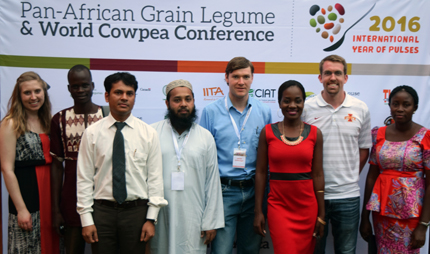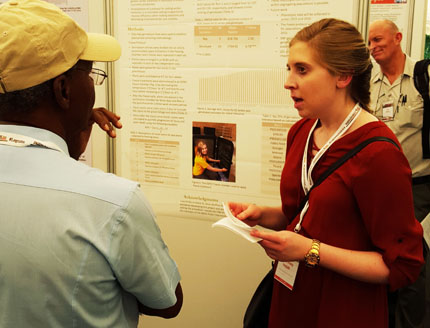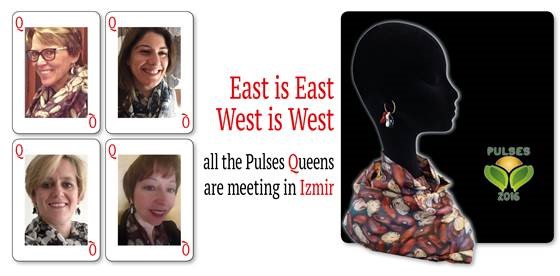- Details
This post was written by Jenny Chandler, Chef and Food blogger. Author of cookbooks "Cool Kids Cook" and "Pulse".
Read the original post, and get the recipes on her blog.
Last week we celebrated The Bristol Food Connections Festival and I was in a whirlwind of cooking (plenty of pulses), teaching, writing, cooking and a bit of gallivanting too. Of course the very mention of the “wind” word will have probably unleashed a bit of school boy humour amongst some of you and I’ll address that at the bottom (oh dear!) of the post.
My demo’ at the festival focused on chickpeas (perhaps my favourite pulse of all, and certainly the variety I use the most) and I had decided, rather bonkersly, to cook 10 recipes in an hour. I often feel that people don’t realise how versatile and easy chickpeas are to use and so, with the help of nine year old Imi, we flew through loads of simple ideas. We did also have some help from the wonderful Clare Hargreaves and Steve Ashcroft – thanks so much to both of you.
Some of the recipes are on my blog already, just click on the links for recipes. We kicked off with farinata , the gram (chickpea) flour flatbread which is super cheap and incredibly moreish (even Gwyneth has included a recipe in her latest cook book, she uses the French name Socca,…. love the idea of putting sardines and tomatoes on the top). Our simple soup has been a go-to-recipe of mine for years, a real store-cupboard standby, with chilli and lemon juice. The zingy Southern Indian chickpea stir fry is a winner if you’re up for some Indian flavours . I only cooked one dish with meat and that was a simple one pot supper dish using a little chorizo , it’s a recipe that really does demonstrate my belief that a small quantity of well-sourced meat can feed a crowd when you cook with pulses. So those are your bonus recipes, and I’ll do my best to post all of the dishes I cooked over time, but today I wanted to talk about salads.
I’d quite happily eat salad every day of my life as long as it was more than a pile of leaves. Nowadays many of the hipster cooks and chefs seem to refer to a large plate of cold goodies as a buddha bowl or wellness plate, I just call it salad. It’s a great option instead of the daily sandwich that so many of us snatch at lunchtime, as long as it tastes fab’, fills you up and keeps you going for the afternoon. As you may know pulses are packed with fibre, are digested slowly and will keep you feeling satisfied and energised for hours. Another upside of chickpeas, beans and lentils in a lunch box is that they actually benefit from a few hours sitting in the dressing, herbs and spices that you may have decided to add. I could bang on about the low fat, no cholesterol, the protein ( when accompanied by grains, nuts or dairy), manganese and folate that chickpeas bring onboard but sometimes singing the health benefits of an ingredient makes people imagine that it will be a trial to eat. THIS SALAD IS DELICIOUS; one of my all time favourites from my book Pulse. I’ve taken a cheeky shot – of the salad pic’ by the fabulous Clare Winfield in my book (I’m up against it, I have a book launch on Wednesday and everything to get ready, so I do hope you’ll forgive).
- Details
This post originally appeared on The co-operative blogs.
In 2013 the United Nations designated 2016 the International Year of the Pulses. So we thought we’d share why we love the little miracles so much.
High in protein, vitamins and minerals, low in fat, cholesterol-free, and a good source of fibre – pulses are disease-busting pulses and can often be cheaper than animal based protein.
Six Reasons to choose pulses…
- Pulses are a great source of protein. This means they can be particularly important for people who do not get protein by eating meat, fish or dairy products.
- Pulses can also be a healthy choice for meat-eaters. You can add pulses to soups, casseroles and meat sauces to add extra texture and flavour. This means you can use less meat, which makes the dish lower in fat and cheaper.
- Pulses are a good source of iron.
- Pulses are also a starchy food and adds fibre to your meal. Eating a diet high in fibre is associated with a reduced risk of heart disease and type 2 diabetes.Pulses protect against diseases.

- An easy way to get 1 of your 5 a day… One portion is 80g, which is around three heaped tablespoons of cooked pulses.
- Pulse crops are one of the most environmentally friendly crops a farmer can grow. Water use in vegetables and pulses is typically much lower than that used in meat production, kg for kg*. Pulses also contribute to soil quality by fixing nitrogen in the soil and are often used as a rotation crop.
If you want to find out more about pulses and get inspired with recipes and facts you can visit the International year of the Pulses’ website here http://iyp2016.org/
- Details
This post was written by Moustafa Elrefaey, Executive Chef & Partner at Zooba Home grown, and the winner of the falafel competition at the London Falafel Festival.
 At Zooba we've been working nonstop to perfect our Taamia (Falafel) recipe for the past four years, since we opened our first restaurant in 2012 in Cairo. We've changed our preparation process over five times just to make sure it has the right texture, crunchy on the outside and soft on the inside. To achieve this in every piece we decided that every order needs to be prepared fresh on the spot; no Taamia can be pre-prepared or pre-cooked.When we first heard about the 2016 London Falafel Festival, we were very excited to just be invited and have the chance to introduce Egyptian Falafel (Taamia) outside of Egypt.
At Zooba we've been working nonstop to perfect our Taamia (Falafel) recipe for the past four years, since we opened our first restaurant in 2012 in Cairo. We've changed our preparation process over five times just to make sure it has the right texture, crunchy on the outside and soft on the inside. To achieve this in every piece we decided that every order needs to be prepared fresh on the spot; no Taamia can be pre-prepared or pre-cooked.When we first heard about the 2016 London Falafel Festival, we were very excited to just be invited and have the chance to introduce Egyptian Falafel (Taamia) outside of Egypt.
The invitation to compete in London came at a perfect time, when we were almost considering ourselves crazy for investing so much time in getting our Taamia recipe just right. It was very refreshing to feel that people care about Taamia (Falafel) as much as we do. We knew that the organizers were keen to include Egyptian Falafel as while it is still one of the most popular street foods in Egypt, its origins date back to the Ancient Egyptians who used Fava Beans, as we still do today, to create a locally available fresh nutritious meal. We believe that Falafel actually originated in Egypt and was then adopted across other cultures that make it with chickpeas or a chickpea and other bean combination. Our recipe stays true to the original recipe keeping it fresh with only fava beans as the base adding green herbs and spices but not overshadowing the original taste with too many ingredients.
For the London Festival we decided to offer one of our more unique and creative items, our Taamia with eggplant and spicy pepper filling. We also added a Tahini with hibiscus and beetroot topping which turned out to be a great hit and we'll now bring back to Egypt. The preparation process in London for the Festival was a bit tedious, as we didn't have our kitchen, our ingredients, our team or our machinery. I basically spent two days in my brother's house outside of London before the event preparing everything to make sure all the ingredients were ready to be cooked and served fresh on the day of the event. I think this is what made the win even more valuable for us as we had to be a bit creative and it took quite an effort to pull it together.
To our surprise the festival tickets were sold out and once the tasting started the queue did not end for three hours. The vibe was great, meeting the other participants and getting a taste of their Taamia was insightful and the reaction of the crowd was incredible; some of them were so passionate and kept coming back for more. We were delighted to be voted by participants as the Best Falafel Recipe and win the inaugural London Falafel Festival Cup. The whole event really surpassed our expectations. This was a great experience and hopefully a new opportunity for Zooba!
- Details
The United Nations declared 2016 as the International Year of Pulses. The aim is to highlight the fundamental importance of securing a sustainable food system to improve our health and dramatically reduce our food footprint, while addressing global food poverty and reversing environmental degradation.
 As part of UNESCO (United Nations Educational, Scientific and Cultural Organisation), the Department of Science and Technology in South Africa has been mandated to include IYP on its 2016 calendar. Its first initiative will be to teach children about the importance of pulses in their diets.
As part of UNESCO (United Nations Educational, Scientific and Cultural Organisation), the Department of Science and Technology in South Africa has been mandated to include IYP on its 2016 calendar. Its first initiative will be to teach children about the importance of pulses in their diets.
DST will be embarking on a roadshow to science centres and schools around the country, aimed at kids aged 8 to 14 years. “Because pulses are so beneficial to people and to our planet, DST wants to motivate our youth to eat them,” says AGT Foods Africa spokesperson Dean Miller.
 DST will visit schools throughout South Africa armed with well-presented material to educate kids to eat pulses. “It explains how pulses are jam-packed with protein, fibre and vitamin B. They are low in fat and salt so they help fight diseases like obesity, cancer, high blood pressure, diabetes and high cholesterol. Most importantly pulses are affordable to all, ensuring poor people get to eat good quality food with all the important nutrients,” says Miller.
DST will visit schools throughout South Africa armed with well-presented material to educate kids to eat pulses. “It explains how pulses are jam-packed with protein, fibre and vitamin B. They are low in fat and salt so they help fight diseases like obesity, cancer, high blood pressure, diabetes and high cholesterol. Most importantly pulses are affordable to all, ensuring poor people get to eat good quality food with all the important nutrients,” says Miller.
ENDS 11 MAY 2016
For further information please contact:
Dean Miller
Group Marketing
Tel: +27 11 762 5261
Or
Kelly Barnett
Caro Communications
Cell: +27 82 776 0231
Notes to editors
- The Global Pulse Confederation (GPC) is the global not for profit trade organisation for the global pulse industry value chain. As the sole international confederation for the industry, it enjoys membership from 18 national associations (federations) and over 600 private sector members in an industry worth over $100 Billion at the retail level and over 60 million tons of pulse production and distribution in over 55 countries. GPC is headquartered in Dubai http://iyp2016.org/about-us/global-pulse-confederation-cicils-iptic
- UN Assembly Resolution on the 2016 International Year of the Pulses: http://www.un.org/en/ga/search/view_doc.asp?symbol=A/RES/68/231&Lang=E
Upcoming Activities
- For recipes, nutrition and health information please visit: www.pulses.org or follow #LovePulses on Facebook, Twitter, Instagram, Pinterest and YouTube.
- For industry news on IYP go to www.iyp2016.org
Promotion on Social Media
Official campaign hashtags: #LovePulses
Dedicated pulse dish hashtag #PulseRecipes
UN International Year of Pulses hashtag: #IYP2016
Handle: @LovePulses
- Details
May 9, 2016 - “The week ended just too soon,” said Vongai Chekanai.

Chekanai was referring to the PanAfrican Legume Conference and World Cowpea Conference, February 28-March 4, in Livingstone, Zambia. She was one of ten students who received travel grants via Crop Science Society of America (CSSA). CSSA is celebrating the International Year of Pulses (IYP) to promote pulses -- crops of dry beans, peas, and lentils. CSSA’s IYP team, led by Mark Brick, thought educating younger researchers by sending them to Zambia would benefit the pulse world.
“We were honored to grant these students the travel awards,” said Brick.
CSSA worked in collaboration with the U.S. Agency for International Development (USAID) and Feed the Future’s Knowledge-Driven Agricultural Development (KDAD) project to fund the students’ travel to the conference. “Collaborating with USAID and KDAD was a natural fit. The world will benefit from having more trained scientists knowledgeable about pulses, and the latest in research efforts,” Brick said.
Their students' enthusiasm may be spreading. “Soon the whole world will be legume crazy,” Chekanai predicted.
The conference was the UN-Food and Agriculture Organization’s signature event for Africa. The program focused on the high nutritional value, stable storage, and soil-building qualities of pulses, which are dry beans, peas, and lentils.
The conference boasted over 500 participants from 6 continents and 46 countries. The theme, “Sustainable grain legume systems for food, income, and nutritional security in a rapidly changing climate,” struck a chord with the students.

“Attending offered me the ability to meet many scientists who are conducting the research I’ve been reading about in school. I engaged in conversations that cannot be duplicated in the classroom,” Lance Goettsch said. Goettsch presented one of nearly 400 posters at the conference, broadening awareness of his research and building valuable communications skills.
“I was already pumped about grain legumes before I attended the conference,” Jamin Smitchger said. “I learned so much about the various grain legumes grown in Africa at the conference.”
Goettsch also pointed out the value of collaboration during the conference. “It was a venue for many young scientists, like me, to interact and discuss the way forward for grain legumes. It also helped us create partnerships that will maximize resources more efficiently.”
Olaotan Adediran found renewed focus for her research. “The need to carry out demand-driven, not publication-driven, research was emphasized,” she said.
CSSA also provided support to the conference with conference logistics, abstract submissions, and program booklet development.
Winners of the competitive CSSA-USAID travel grants were Md Nurul Amin, Washington State University; Brijesh Angira, Texas A&M University; Lance Goettsch, Iowa State University; Jamin Smitchger, Montana State University; Olaotan Abimbola Adediran, Federal University of Technology; Courtney Holdt, North Dakota State University; Matthew Berry, Michigan State University; Vongai Chekanai, University of Zimbabwe; Dennis Ndahura Katuuramu, Michigan State University; Awio Bruno, Makerere University.
Travel grant judges were Mark Brick, Colorado State University; Roch Gaussoin, University of Nebraska-Lincoln; Michael Grusak, USDA-ARS; Juan Osorno, North Dakota State University; Jennifer Long, USAID; Bir B. Singh, G.B. Pant University of Agriculture & Technology; Clarice Coyne, USDA-ARS.
The United Nations Food and Agriculture Organization declared 2016 the International Year of Pulses (IYP). In celebration, the Crop Science Society of America (CSSA) created a web page for the public about pulses, www.crops.org/iyp. Special tabs for the public include K-12 Education, Beans in the News, Grown Your Own, and Delicious Ideas. CSSA has also compiled links to various recipes, so you can increase your consumption of pulses.
CSSA will release more information about pulses during the 2016 IYP celebration.
Check out more stories about the International Year of Pulses here.
- Details

Beautiful scarves and earrings will be sold at the GPC Convention next week in Cesme, Izmir, Turkey to raise funds for IYP activities. Be sure to purchase pulse-themed jewelry for yourself and friends to show your support for the International Year of Pulses!